Find Famous Rochestarians and Bid on Them Today!
Here, you’ll find all our Famous Rochestarians, their bios, and the artists’ bios. If you’d like to bid on them, just click on the big red “Bid Now” buttons and it will take you directly to our bidding page.

Jason Barber
Louise Brooks
Lifespan: 1906 – 1985
Brief Family History: Louise Brooks was
born in Cherryvale, Kansas, to Leonard Porter Brooks and Myra Rude and grew up alongside her three siblings.
Career & Interests: Brooks started her career as a dancer before transitioning to silent films. She became an iconic flapper and actress, renowned for her roles in “Pandora’s Box” and “Diary of a Lost Girl.” Her interests extended beyond acting to literature, dance, and film, which she documented extensively in her notebooks.
Noteworthy Accomplishments: Brooks became a film icon of the Jazz Age, celebrated for her distinctive bob haircut and captivating screen presence. Her work in German silent films, particularly under the direction of G.W. Pabst remains critically acclaimed. After her film career waned, Louise Brooks moved to Rochester, New York, where she spent her later years. She was closely associated with the George Eastman Museum, contributing 29 research journals of notes on readings and film viewings, which have become valuable resources for scholars studying early cinema. Her collection of autobiographical essays, Lulu in Hollywood was published in 1982. She is buried in Holy Sepulchre Cemetery.

George Eastman
Lifespan: 1854 – 1932
Brief Family History: George Eastman was born in Waterville, New York. His father, George Washington Eastman, founded Eastman’s Commercial College in Rochester in 1854. The family moved to Rochester in 1860, and he grew up with his mother, Maria Kilbourne Eastman, and his two older sisters after his father died.
Career & Interests: Eastman began his career working for an insurance company and later a bank. His interest in photography was sparked in 1874 when a colleague suggested he document his travels. zFrustrated with the cumbersome equipment, he experimented in his mother’s kitchen to simplify the process. This led to his invention and patent of a dryplate coating machine in 1880. In 1881, with financial backing from Henry Strong, he founded the Eastman Dry Plate Company, which later became Eastman Kodak Company in 1892.
Noteworthy Accomplishments: Eastman revolutionized photography with the introduction of roll film and the Kodak camera in 1888, making photography accessible to amateurs. His contributions significantly impacted Rochester, turning it into a center for the photographic industry. Eastman donated more than $100 million to various institutions, including the University of Rochester and the Eastman School of Music. His legacy in Rochester continues through these contributions and the establishment of the George Eastman Museum, a leading institution in the history of photography and film.
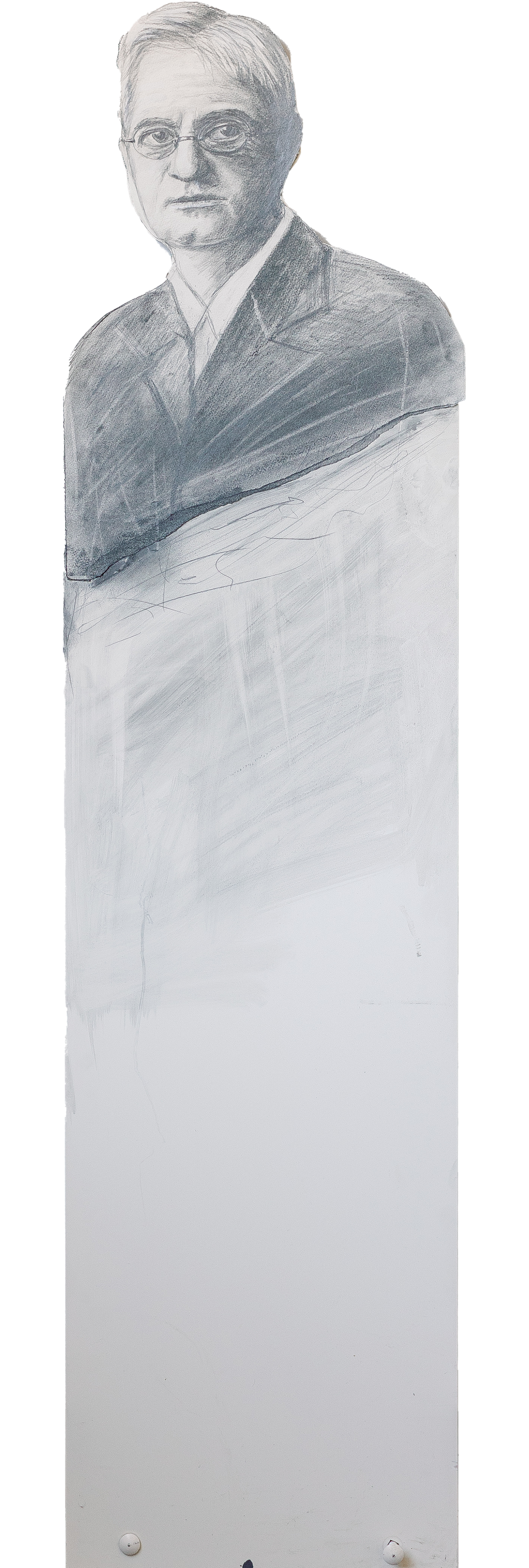

Molly O’Reilly
Kate Gleason
(This piece has been SOLD)
Lifespan: 1865-1933
Brief Family History: Kate Gleason was born in Rochester, NY, to William and Ellen McDermott Gleason. Her father owned a machine tool company, which played a significant role in her early interest and education in mechanical engineering.
Career & Interests: Kate Gleason started working in her father’s company, Gleason Works, at a young age, showing skills in mechanical engineering and business. She later studied at Cornell University and the Mechanics Institute (now RIT). Kate became the first woman member of the American Society of Mechanical Engineers (ASME). Her interests extended to real estate development and banking, showcasing her versatility.
Noteworthy Accomplishments: Kate helped her father revolutionize the machine tool industry with innovative gear-cutting technology, by expanding Gleason Works internationally. She was the first woman elected to full membership in ASME. Her real estate ventures created affordable housing, and she became the first woman president of a local bank. One of her first affordable concrete housing projects still exists in East Rochester.
Her business acumen and involvement in building affordable housing helped transform Rochester into a thriving industrial hub. Her philanthropic efforts, commitment to women’s rights, and her community development left a lasting legacy.
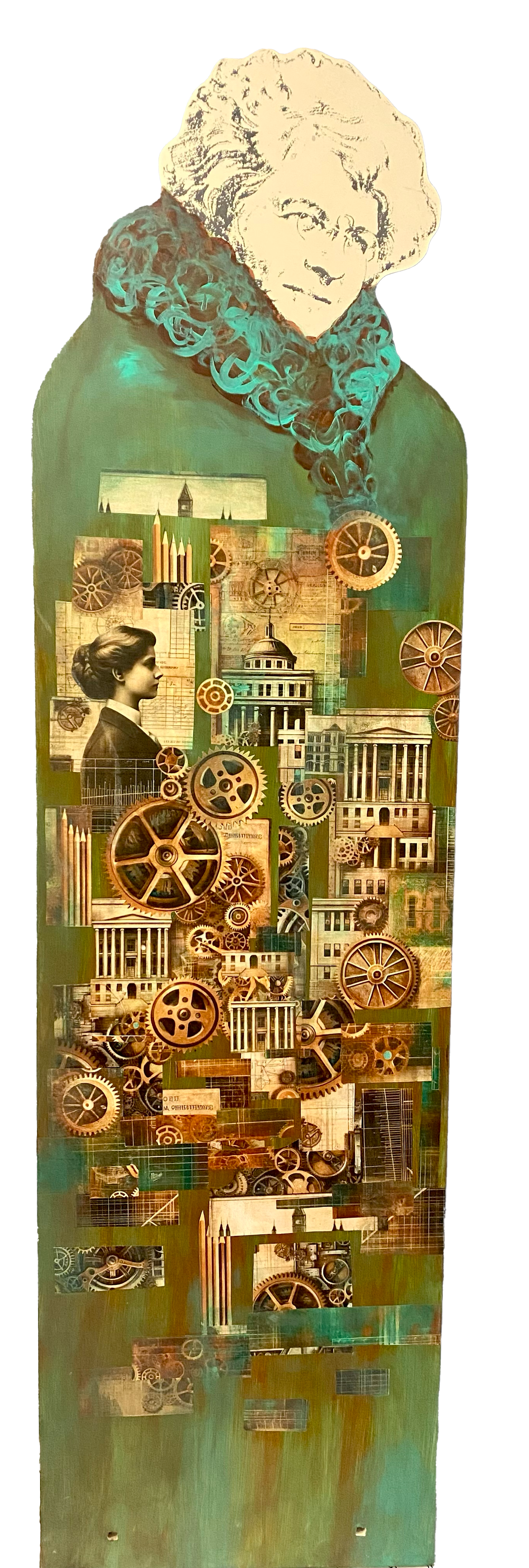
Claude Bragdon
Lifespan: 1866-1946
Brief Family History: Claude Fayette Bragdon was born in Oberlin, Ohio. He married Charlotte Wilkinson in 1903.
Career & Interests:Claude Bragdon was an architect, writer, and artist with a significant focus on Rochester, NY. He began his architectural career in Rochester, working in partnership with Edwin S. Gordon and William H. Orchard. Bragdon’s interests extended beyond architecture to include graphic design and literature, reflecting his multifaceted artistic inclinations.
Noteworthy Accomplishments:Bragdon made substantial contributions to Rochester’s architectural landscape that exist today. His notable works include the Rochester Athletic Club, Memorial Art Gallery, and The First Universalist Church on Court Street. In 1912, he was commissioned to build Rochester’s New York Central Railroad Station, acknowledged to be his architectural masterpiece, which was torn down in the 1960’s.
Bragdon’s work often incorporated elements of Theosophy and geometric ornamentation, showcasing his unique style. His influence extended to urban planning and community design, making him a prominent figure in the development of Rochester’s architectural heritage.
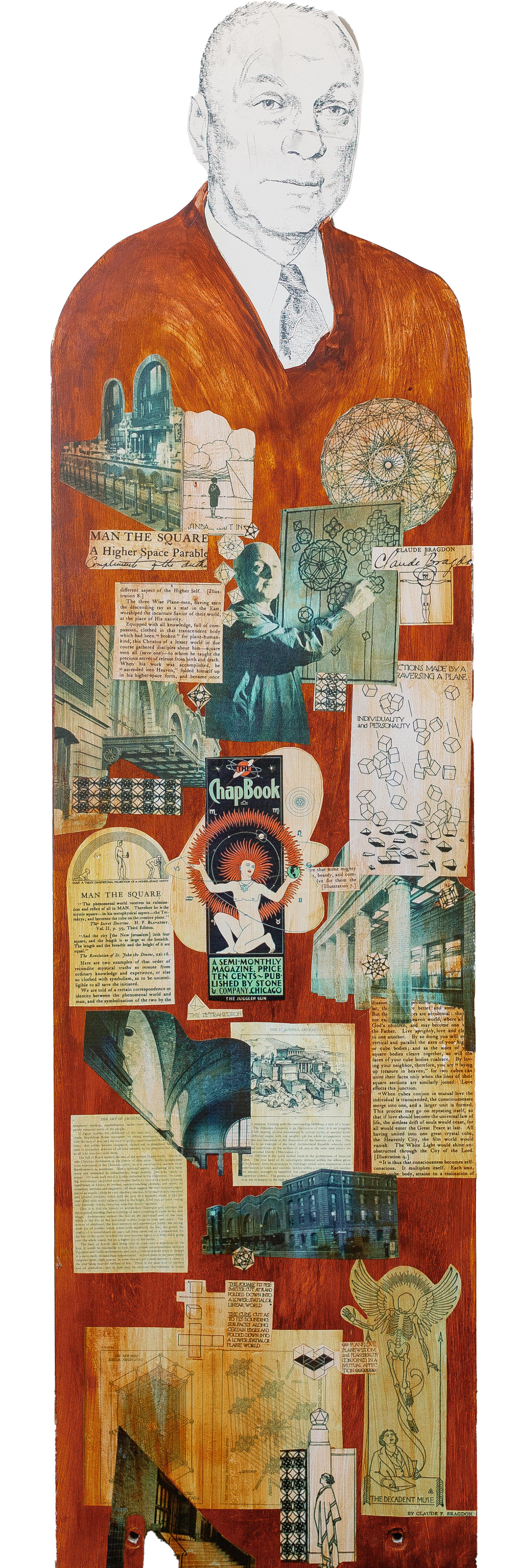
George Herdle
Lifespan: 1868 – 1922
Brief Family History:George Leonard Herdle was born in Rochester, New York, where he grew up and became father to his two daughters, Gertrude Herdle Moore and Isabel Herdle.
Career & Interests:Before 1913, Herdle was a freelance artist and taught at the Rochester Athenaeum and Mechanics Institute (now RIT). As President of the Rochester Art Club from 1902 to 1920, he played a pivotal role in the local art community. In 1913, he became the first director of the Memorial Art Gallery (MAG) in Rochester.
Noteworthy Accomplishments:Herdle’s tenure at the Memorial Art Gallery began with the Gallery’s inaugural exhibition, showcasing contemporary American artists. Friends with many prominent artists, Herdle’s exhibition featured George Bellows,Wnslow Homer, and George Inness He facilitated significant exhibitions, including the first Kodachrome color photography exhibition in 1914 and oneman shows featuring works by James McNeill Whistler and George Bellows. His efforts helped establish the Memorial Art Gallery as a prominent cultural institution in Rochester. His legacy continued though his daughter Gertrude, who succeeded him as director of the Memorial Art Gallery in 1922 and served for the next 40 years. She was joined 10 years later by her sister Isabel who served as assistant director.
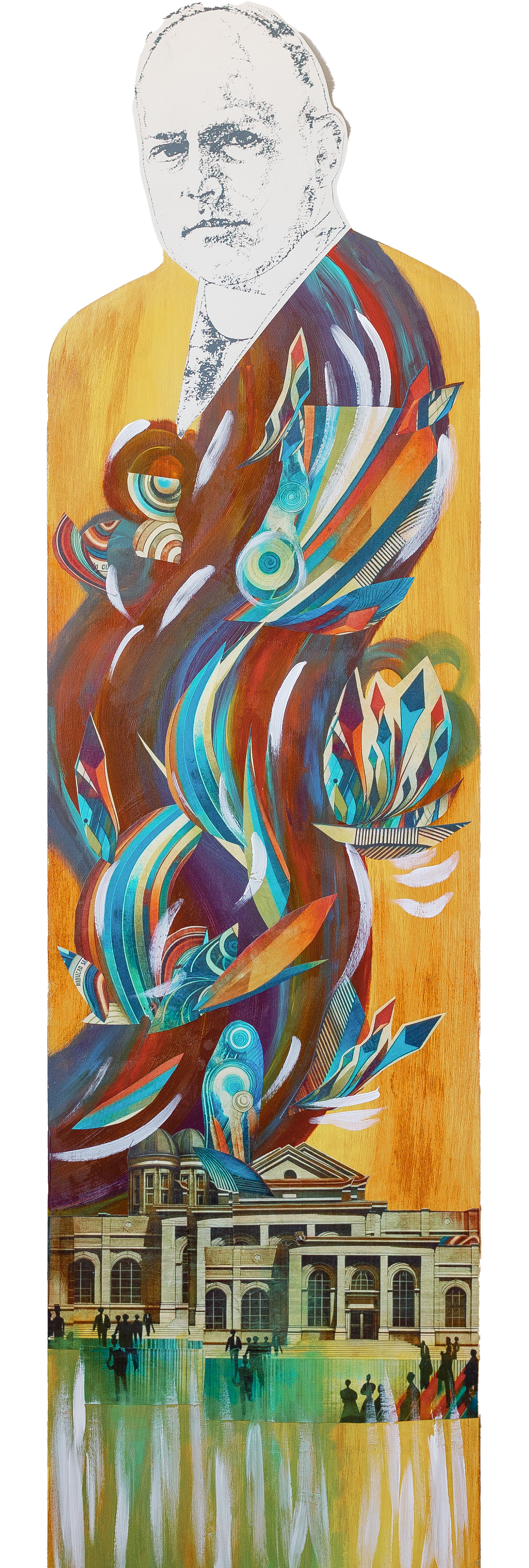

Angie Carter
Sister Hieronymo O’Brien
Lifespan: 1819–1898
Brief Family History:Sister Hieronymo O’Brien was raised in a family deeply rooted in strong religious values, which profoundly influenced her lifelong commitment to faith and service.
Career & Interests: At age 22, she joined the Daughters of Charity, a religious order formed by the first native-born American saint, Elizabeth Ann Seton. After training as a nurse, Sister Hieronymo dedicated herself to education and community service. She played a pivotal role in providing quality health care, quality schooling and spiritual guidance to the Rochester community, while also advocating for social justice and supporting marginalized communities.
Noteworthy Accomplishments: Her skills as a nurse led her to Rochester to establish the first permanent hospital, St Mary’s in 1857. Transferred to New Orleans for only a short time, she returned to Rochester to open the Home for Industry for young girls in 1873. Sister Hieronymo left an enduring mark through her leadership in health care, educational initiatives and community outreach. She significantly expanded educational opportunities for underprivileged children, enhancing the city’s educational framework. Sister Hieronymo O’Brien’s legacy is defined by her unwavering dedication to faith, education, social justice, and compassionate service.


Ron Ferrera
Ebenezar Allen
Lifespan: 1743–1814
Brief Family History: Ebenezer “Indian” Allan was born in New Jersey in 1743. He had several wives and married a Delaware Indian woman, aligning himself with Native American communities. His family connections with Native Americans earned him the nickname “Indian” Allan.
Career & Interests: Allan was a controversial and violent figure during the American Revolutionary War. Initially siding with the British, he was a member of Butler’s Rangers, an army that along with Indian allies massacred settlers. An opportunist, he switched allegiances to the American cause acting as a peace negotiator with the Six Nations. He was known for his resourcefulness and adaptability, navigating the complex dynamics between American settlers and Native American tribes. Allan was deeply involved in land speculation and settlement of the Genesee Valley region, which later became part of New York State.
Noteworthy Accomplishments: Allan’s most notable accomplishment was his role in the early settlement of Genesee Valley. The Phelps and Gorham Purchase of millions of acres east of the Genesee River included the 100 acre tract on the west side that became Rochester. Allan was commissioned to build a lumber and gristmill at the Genesee Falls to serve both Indians and new settlers, becoming the first white man in the Rochester area. He eventually abandoned the unprofitable mills. His efforts in the Genesee Valley significantly impacted the growth and development of Rochester, NY. Allan built the first mills on the Genesee River, laying the groundwork for Rochester’s transformation into the Flour City and an industrial and commercial hub.

Howard Hanson
Lifespan: 1896–1981
Brief Family History: Howard Hanson was born in Wahoo, Nebraska, to Swedish immigrant parents. His father, Hans Hanson, was a store owner, and his mother, Hilma Eckstrom Hanson, was a musician, fostering a culturally rich environment.
Career & Interests: Hanson was an influential American composer, conductor, educator, and music theorist. He studied at the Institute of Musical Art in New York and Northwestern University, earning a Bachelor of Music degree. In 1921, he became the first American to win the Prix de Rome, studying in Italy. Hanson’s career peaked when he became the director of the Eastman School of Music at the University of Rochester in 1924, a role he held for 40 years, transforming it into a premier music institution.
Noteworthy Accomplishments: Hanson’s tenure at Eastman marked significant contributions to American music education and composition. He founded the Eastman- Rochester Orchestra and promoted American music through the American Composers Orchestral Concerts. A daring move in 1925. His notable works include “Symphony No. 2, ‘Romantic'” and the Pulitzer Prizewinning “Symphony No. 4.” Hanson received numerous awards, including a Peabody Award for his service to music. His legacy endures through his compositions, recordings, and the many students he mentored who achieved prominence in the musical world.

Daniel Powers
Lifespan: 1818–1897
Brief Family History: Daniel Powers was born in 1818 in Cayuga County, New York. Coming from a modest background, he moved to Rochester as a young man, determined to make a name for himself in the burgeoning city.
Career & Interests: Powers began his career in Rochester working as a clerk before venturing into the dry goods business. His keen business acumen and entrepreneurial spirit led him to success. Powers had a deep interest in real estate and construction, which became a significant part of his legacy.
Noteworthy Accomplishments: Daniel Powers is best known for constructing the Powers Building in downtown Rochester, a city landmark. Completed in 1869, the building was initially five stories high and the tallest structure in Rochester at the time. Powers expanded and renovated the building to 11 stories, making it one of the tallest buildings in New York State outside of New York City. It was the first in the city to have elevators.
Powers also created the Powers Art Gallery within his building, showcasing an extensive collection of paintings and art pieces, promoting cultural development in the city. His contributions to Rochester’s architectural landscape and cultural heritage were profound, leaving a lasting impact on the city’s development and identity.
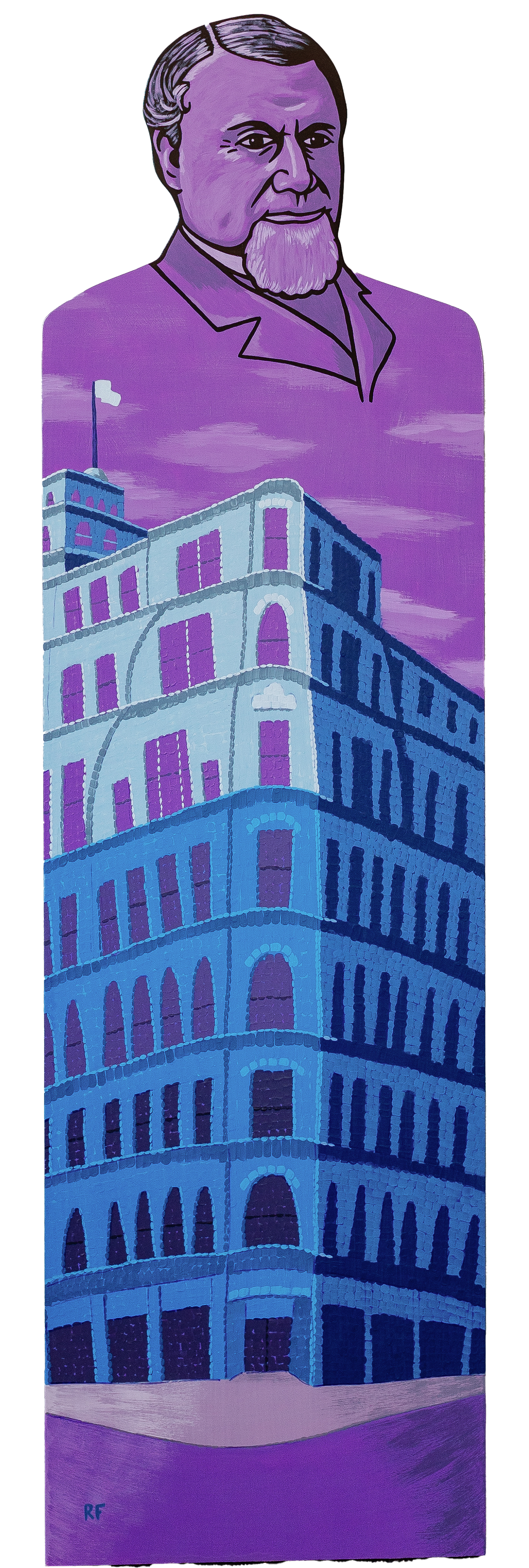

Mikayla Bader
Currently based in Upstate NY, she has a studio in the Shirt Factory in Glens Falls. Through art, Mikayla aims to forge moments of connection and visibility, where both realism and expression can coexist. Her inspiration stems from people, life, and the myriad colors within her body of work. The design of her characters was inspired by the advertising of their local companies that changed the world.
Hiram Sibley
Lifespan: 1807–1888
Brief Family History: Born into a modest family in Massachusetts, Sibley’s early life was marked by hardship. However, his ambition and determination propelled him to success.
Career & Interests: Sibley’s career began in telegraphy, where he played a pivotal role in the expansion of the telegraph network across the United States. He founded the Western Union Telegraph Company and served as its President, revolutionizing communication on a national scale. Sibley’s interests extended beyond business; he was deeply committed to philanthropy and public service, advocating for initiatives to improve the lives of workers and their families.
Noteworthy Accomplishments: Sibley’s impact on Rochester, NY, is profound. Under his leadership, Western Union laid the first transcontinental telegraph line in 1861. His investments in telegraph infrastructure connected Rochester to major cities and facilitated economic growth in the region. He supported education and social reform initiatives, leaving a legacy in the form of the Sibley College of Mechanic Arts at Cornell University and the University of Rochester’s first library building in 1870’s. Sibley’s advocacy for workers’ rights and support for initiatives to improve the quality of life for residents demonstrated his dedication to building a stronger, more equitable community.

Captain Henry Lomb + John Jacob Bausch
Captain Henry Lomb
Lifespan: (1828–1908)
John Jacob Bausch
Lifespan: (1830–1926)
Brief Family History: Captain Henry Lomb & John Jacob Bausch were visionary entrepreneurs who co-founded the Bausch & Lomb Optical Company, leaving an enduring legacy in Rochester, NY. Lomb, a German immigrant, and Bausch, a Swiss immigrant, shared a passion for optics and innovation.
Career & Interests: Lomb was a carpenter before investing all his savings in Bausch’s optical shop in Rochester. Their partnership flourished as they combined Lomb’s business acumen with Bausch’s technical expertise. Together, they revolutionized the optical industry, pioneering the manufacturing of eyeglass frames and lenses. Their commitment to quality and innovation propelled Bausch & Lomb to international renown, with their products earning accolades worldwide.
Noteworthy Accomplishments: By 1885, Bausch & Lomb was Rochester’s largest industry, and it would grow to be the biggest optical company in the world offering an array of new products including the first soft contact lenses. A cornerstone of the city’s economy, it provided employment opportunities and contributed to its growth. Bausch & Lomb’s legacy in Rochester includes the establishment of educational and cultural institutions. Seeing the need for skilled workers in the 1880’s, Lomb led the push to found and support the Mechanics Institute which evolved into the Rochester Institute for Technology. Their commitment to philanthropy, educational initiatives, and community development left a lasting imprint on Rochester.
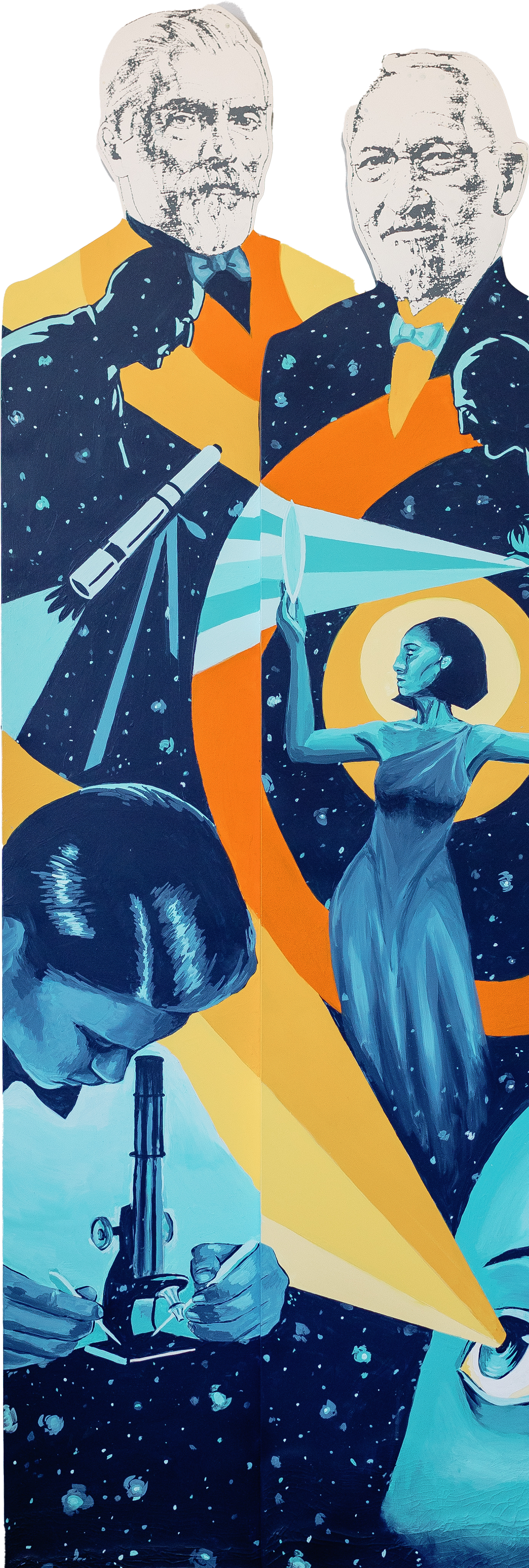

Audrey Brown
Currently a graphic designer, Audrey constantly experiments with different techniques and mediums. She deeply appreciates Rochester’s commitment to preserving native wildlife and area history. Her art features the vibrancy of flora and fauna and explores its intricacies and beauty. Her goal is to educate the viewer as to the impact on nature and society these historical figures had on Rochester.
Chester Dewey
Lifespan: 1784–1867
Brief Family History: Chester Dewey was a distinguished American botanist and educator, renowned for his contributions to the field of natural sciences. Born in Massachusetts, Dewey hailed from a family of educators and scholars, fostering his early interest in botany and natural history.
Career & Interests: After graduating from Williams College,Dewey began his teaching career at his alma mater where he pursued his passion for botany and education. In 1850, he became a founding faculty member at the University of Rochester, where he made significant contributions to the development of the natural sciences curriculum. Dewey’s dedication to teaching and research earned him widespread recognition as a leading authority in his field.
Noteworthy Accomplishments: Among his noteworthy accomplishments, Dewey is renowned for his extensive botanical studies and publications. His research on plant taxonomy and morphology laid the foundation for modern botanical classification systems, influencing generations of botanists and scientists worldwide.
Dewey’s impact on Rochester’s scientific community is significant. inspiring future generations of scientists and educators to pursue knowledge and understanding of the natural world. Dewey’s legacy continues to resonate in Rochester, serving as a testament to the power of education and scientific inquiry in shaping the future of our community.

Lewis Henry Morgan
Lifespan: 1818–1881
Brief Family History: Lewis Henry Morgan was a distinguished American anthropologist whose groundbreaking work left an indelible mark on Rochester, NY, and the field of anthropology. Born in Aurora, New York, into a family with deep roots in the region, Morgan’s upbringing instilled in him a passion for learning and exploration.
Career & Interests: Morgan began his career as a lawyer and served in the NYS Assembly and Senate. In the 1840’s, he developed a keen interest in anthropology, particularly the study of Indigenous cultures. He conducted extensive research on the social organization and kinship systems of Native American tribes, and developed the idea of cultural evolution laying the foundation for modern anthropological theory.
Noteworthy Accomplishments: Among his noteworthy accomplishments, Morgan’s impact on Rochester, NY, is profound. He played a pivotal role in establishing the University of Rochester’s reputation as a center for anthropological research and education. Additionally, Morgan’s philanthropic endeavors benefited the local community, his will ultimately directed the remainder of his fortune to establish a women’s college at the University of Rochester.

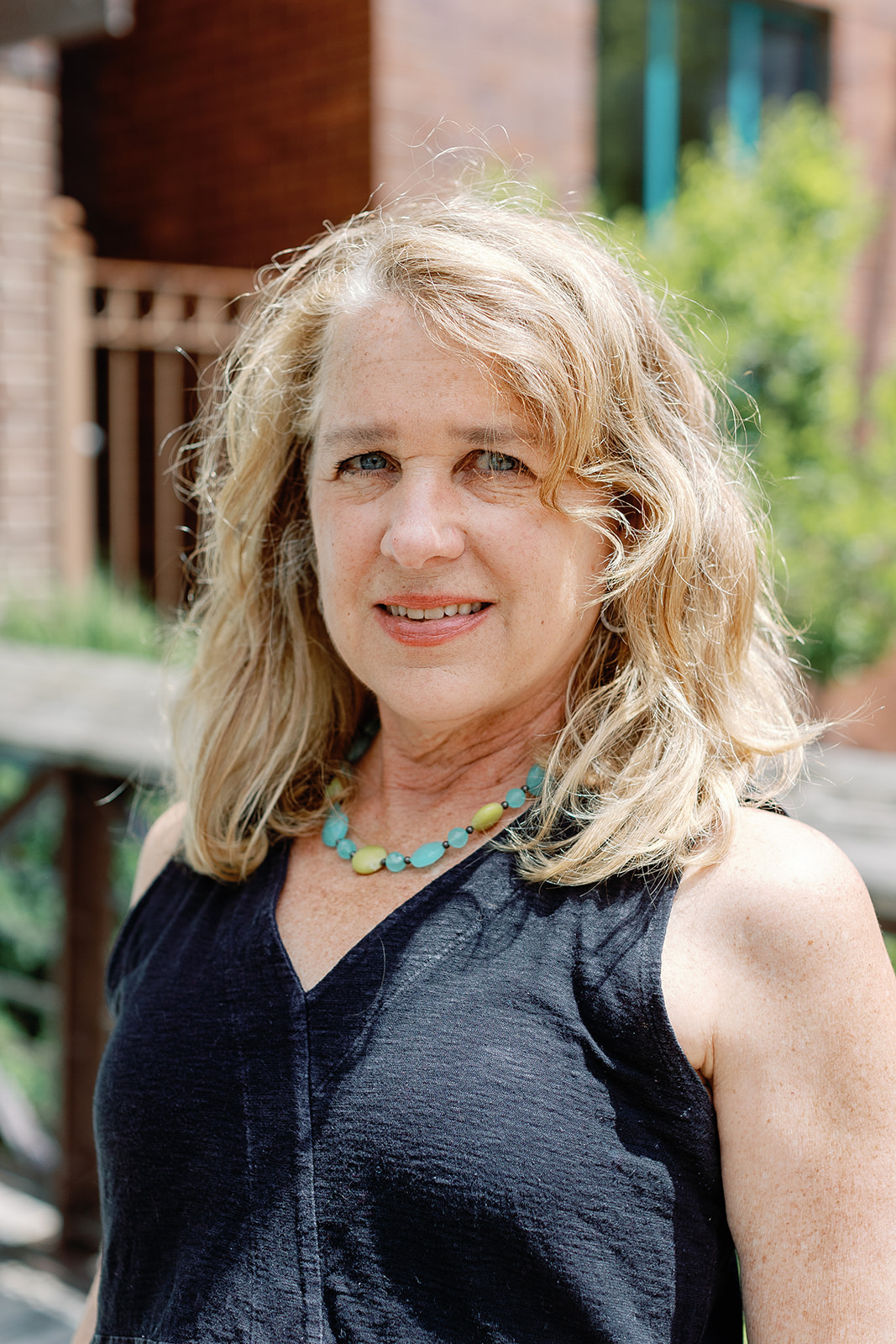
Sarah Shaw
With an education and museum background, she considers herself a multidisciplinary artist. Sara currently enjoys collage and photography. She is inspired by nature and beauty. Her floral mosaic collage is an ode to landscapers Ellwanger and Barry who put the “flower” in Flower City. The photomosaic city building skyline collage is a testament to the Warners hardscape design work that made the city of Rochester.
Ellwanger + Barry
Lifespan: George Ellwanger: 1816-1906
Patrick Barry: 1816-1890
Brief Family History: Ellwanger & Barry was founded by George Ellwanger, a German immigrant from Grossheppach, Germany, and Patrick Barry, an Irish immigrant from Belfast, Ireland.
Career & Interests: Ellwanger & Barry were pioneers in the nursery business, focusing on the cultivation and distribution of fruit trees, ornamental plants, and flowers. Their interests extended beyond horticulture into community development and public service, where they actively participated in urban planning and civic improvements.
Noteworthy Accomplishments: Ellwanger & Barry significantly influenced the landscape of Rochester by introducing numerous plant varieties and elevating the city’s reputation in horticulture. Their nursery became one of the largest and most respected in the United States. They donated land for the creation of Highland Park, a cherished public space known for its annual Lilac Festival, which features many of the plants they cultivated. Their contributions to the city also include residential developments that reflected their aesthetic vision and commitment to creating beautiful, green urban spaces.
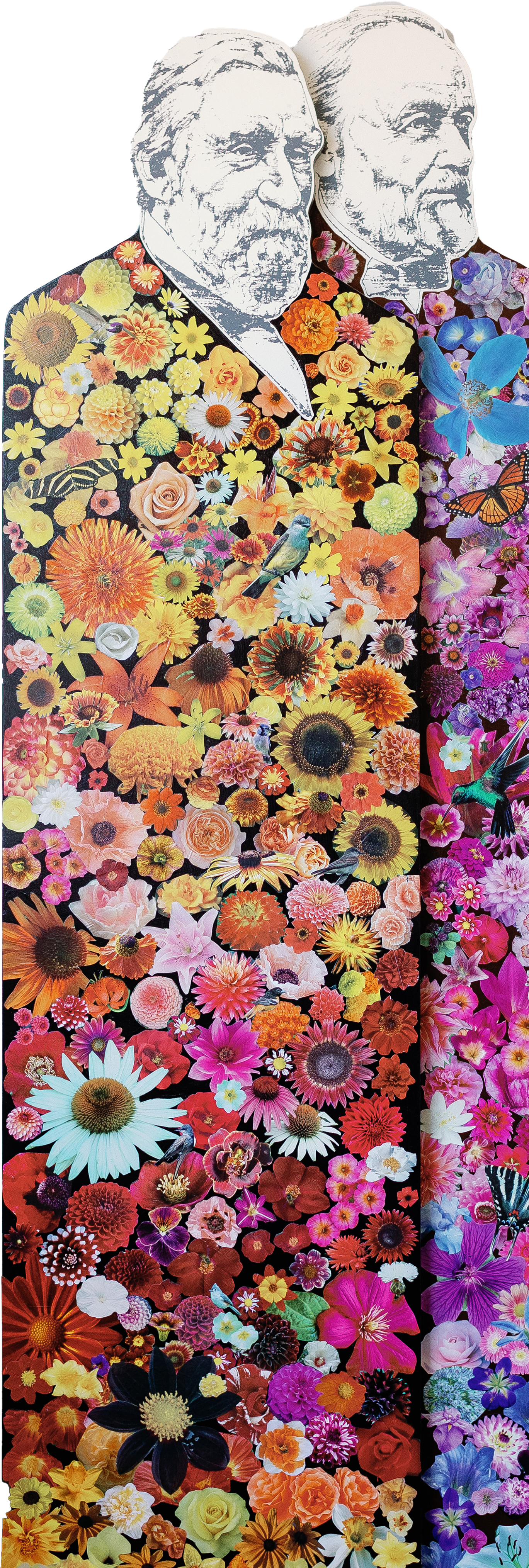
The Warners of Rochester
Lifespan:
Andrew Jackson Warner: (1833-1910)
John Foster Warner: (1859-1937)
Brief Family History:
Andrew Jackson Warner and John Foster Warner were a father-son duo who significantly influenced Rochester, NY’s architectural landscape. Andrew, born in Farmington, NY, became a leading architect after training in Syracuse. John, Andrew’s son, continued the family tradition after studying at MIT and traveling extensively in Europe to refine his skills.
Career & Interests:
Andrew’s interest in Victorian and Romanesque styles led to notable projects such as the original Rochester Savings Bank and Asbury First United Methodist Church, shaping the city’s architectural character in the late 19th century.John expanded the family portfolio with designs that reflected the evolving tastes of the early 20th century. His interests spanned residential, commercial, and institutional architecture.
Noteworthy Accomplishments:
Andrew designed several significant structures that became integral parts of Rochester’s urban fabric. John, continuing his father’s legacy into the early 20th century, introduced a blend of classical elements and modern innovations in his designs. His projects, notably the Powers Building and the Monroe County Office Building, and the George Eastman House that became iconic symbols of Rochester’s burgeoning urban development.
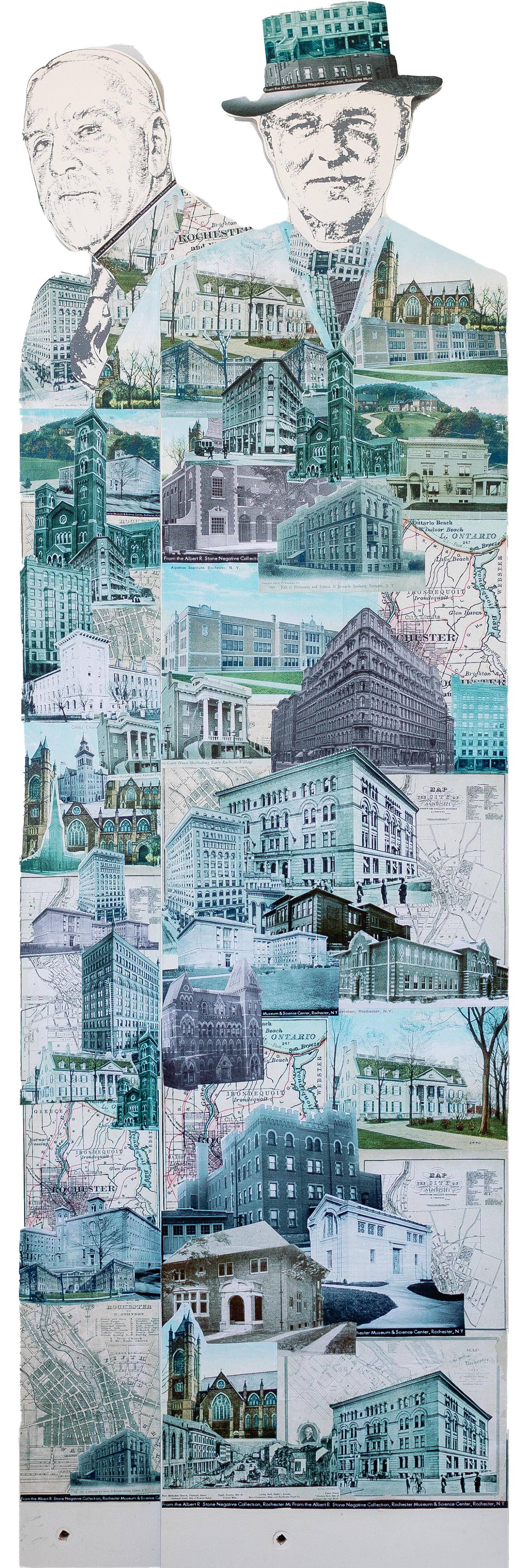
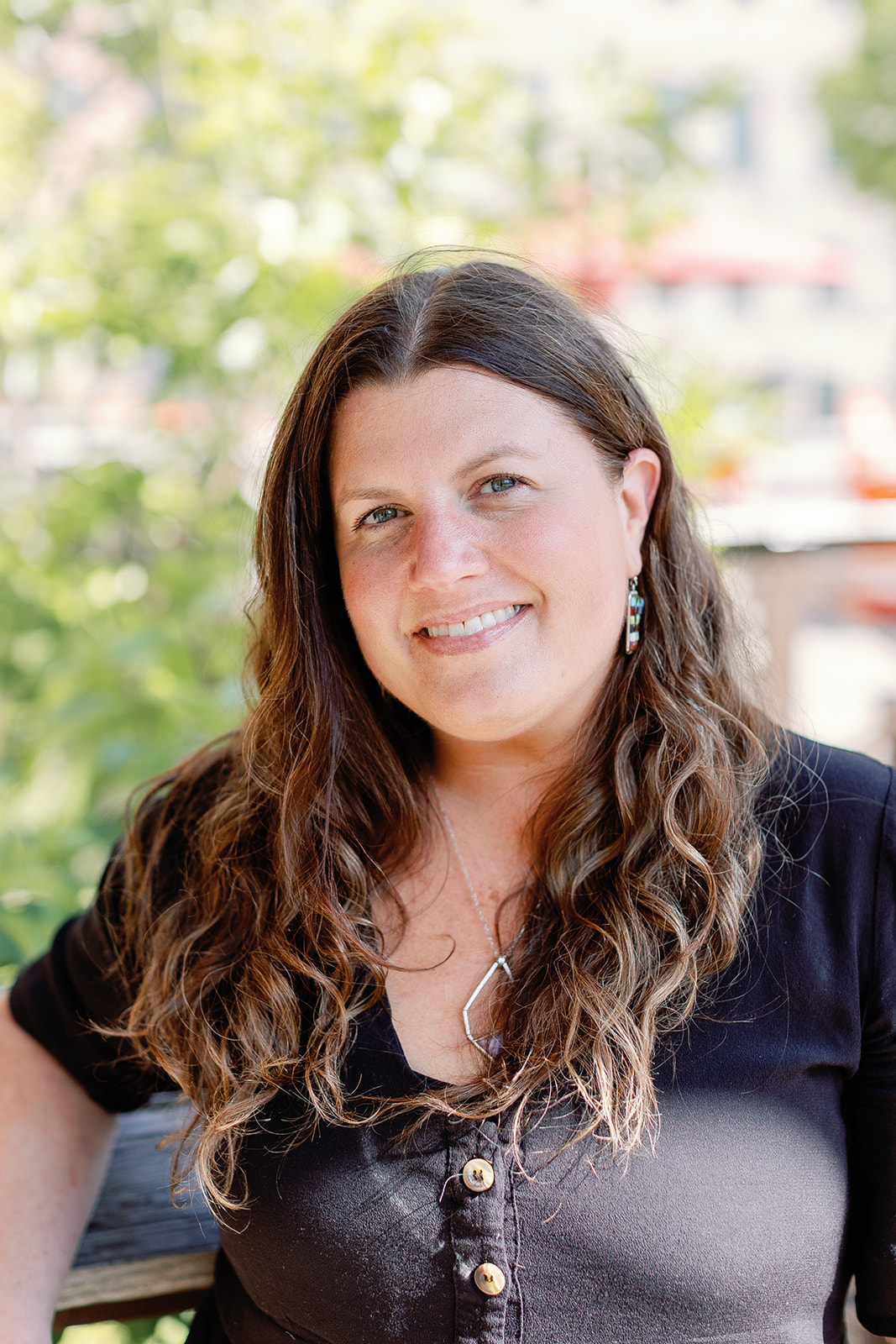
Brandi Marino
Brandi is a mother, painter, and daydreamer. Brandi’s favorite portraits of people are the ones she made herself. She is a mixed media artist, who primarily paints on salvaged wood, mostly large format, bold colors with botanical themes. She was inspired to portray Rochester heroes who bucked the system and blazed a new trail that benefited the Rochester community.
Seth Green
Lifespan: 1817 – 1888
Brief Family History: Seth Green was born in the town of Sullivan, New York, where he grew up on his family farm alongside his five older siblings.
Career & Interests: Green was an avid fisherman from a young age. He started his career as a fur trader but soon focused on fish culture, becoming one of the foremost pioneers in fish propagation. His interest in fisheries led him to extensive studies and experiments, culminating in significant advancements in the field. Green’s work in fish hatching and aquaculture set the foundation for modern practices in these areas.
Noteworthy Accomplishments: Seth Green, renowned for establishing the first fish hatchery in the United States at Caledonia, near Rochester, in 1864, profoundly influenced the fishing industry and local ecosystems. His innovations in fish breeding and hatchery techniques, detailed in numerous publications, shaped national fishery programs and policies. Green’s pioneering hatchery became a model for similar projects nationwide, solidifying his legacy as a pivotal figure in American fish culture and establishing Rochester as a hub for fish breeding research and development.

Henry O’Reilly
Lifespan: 1806-1886
Brief Family History: Henry O’Reilly was born in Carrickmacross, County Monaghan, Ireland. In 1816, his parents, Edward and Margaret O’Reilly, moved the family to the United States.
Career & Interests: Henry O’Reilly began his career in the printing industry in New York City before moving to Rochester, NY, in 1826. In Rochester, he quickly became a prominent figure, working as the editor of the Rochester Daily Advertiser and later establishing the Rochester Republican. O’Reilly was deeply involved in public infrastructure and civic development, advocating for the expansion of canals, railroads, and telegraph lines. He was an ardent supporter of public education and civic improvement projects.
Noteworthy Accomplishments: In Rochester, O’Reilly played a pivotal role in the city’s development. He was instrumental in securing Rochester’s city charter in 1834, which provided a framework for its governance and growth. His advocacy for the Erie Canal significantly boosted Rochester’s economy by improving trade and transportation. O’Reilly’s most notable contribution was in the realm of telegraphy. He was a key figure in the establishment of telegraph lines across the United States, which greatly enhanced national communication networks. His journalistic efforts led him to write a book Settlement of the West: Sketches of Rochester still available in print today

Dr. Wende Logan
Lifespan: 1942-2010
Brief Family History: Wende Logan was born in 1942 in Buffalo, New York to her mother, Elizabeth Wende.
Career & Interests: Dr. Wende Logan was a dedicated and innovative physician specializing in breast imaging and diagnosis. She graduated from the University at Buffalo Medical School and completed her residency in diagnostic radiology. Her career was marked by a profound commitment to advancing women’s health. Dr. Wende Logan was also an advocate for breast cancer awareness and education, often participating in community outreach programs to educate women about the importance of regular screenings.
Noteworthy Accomplishments: Dr. Wende Logan made significant contributions to Rochester, New York, through her pioneering work in breast health. The Elizabeth Wende Breast Clinic, under her leadership, became a national model for breast cancer detection and care. Her innovative approach included the adoption of advanced imaging technologies and a multidisciplinary team strategy, which significantly improved the accuracy of breast cancer diagnoses. Dr. Wende Logan’s clinic was one of the first in the country to use digital mammography, enhancing early detection rates and saving countless lives. Her impact is felt in Rochester through the lives she touched and the advancements she championed in women’s healthcare.

Kitty Van Bortel
Lifespan: 1954 – Present
Brief Family History: Kitty Van Bortel grew up in Rochester, NY, under the strong influence from her father, who was a successful car dealer.
Career & Interests: Kitty began her career in the automotive industry in the late 1970s, selling cars at Ridley Ford in Webster, NY. Her passion for cars and dedication to customer service quickly set her apart in a male-dominated field. Over the years, Kitty expanded her career by establishing several successful dealerships, including Van Bortel Subaru, Van Bortel Ford, and Van Bortel Chevrolet. Her interests extend beyond the automotive industry; she is also passionate about community service and animal welfare.
Noteworthy Accomplishments: Kitty Van Bortel has made significant contributions to the automotive industry, particularly in Rochester, NY. She is recognized as one of the top Subaru dealers in the United States, earning numerous awards for sales and customer satisfaction. She has been a trailblazer for women in the automotive business, breaking barriers and serving as an inspiration for future generations. Additionally, Kitty is an active philanthropist, supporting various local charities and animal rescue organizations. Her commitment to excellence and community involvement has solidified her reputation as a leader and pioneer, not only in Rochester but nationwide in the automotive industry.


Hayley Dayis
Inspired to search for alternatives to chemical acrylics. Hayley unearths color from the natural landscape to tell stories of land and humanity on canvas.She made the paint used in Red Jacket from clay found in Seneca Park, representing the connection to his ancestral home. The crying bear is a metaphor for Red Jacket, a strong willed, thoughtful person who went through much change and pain in life.
Red Jacket
Lifespan: 1750-1830
Brief Family History: Red Jacket, originally named Otetiani and later known as Sagoyewatha, was born in the Seneca village of Canoga. His mother was from the Seneca tribe, and his father was likely from the Cayuga tribe.
Career & Interests: Red Jacket emerged as a distinguished Seneca chief and orator, known for his eloquent speeches and steadfast defense of Native American rights and culture. He was deeply invested in preserving the traditional Seneca way of life and became a vocal opponent of the spread of Christianity among his people.
Noteworthy Accomplishments: Red Jacket is best remembered for his exceptional oratory skills and his unwavering commitment to his people. His most famous speech, “Religion for the White Man and the Red,” eloquently defended the Seneca’s right to their religious beliefs and way of life in the face of missionary efforts to convert them to Christianity. In 1792, he traveled to Philadelphia to meet President George Washington, where he received a silver medal as a symbol of peace and friendship.Red Jacket signed the Treaty of Canandaigua in 1794 which confirmed peace with the Haudenosaunee and the United States. In recognition of his contributions, Red Jacket’s name is honored at the Red Jacket High School in Shortsville, NY, ensuring that his legacy of leadership and advocacy is remembered by future generations.

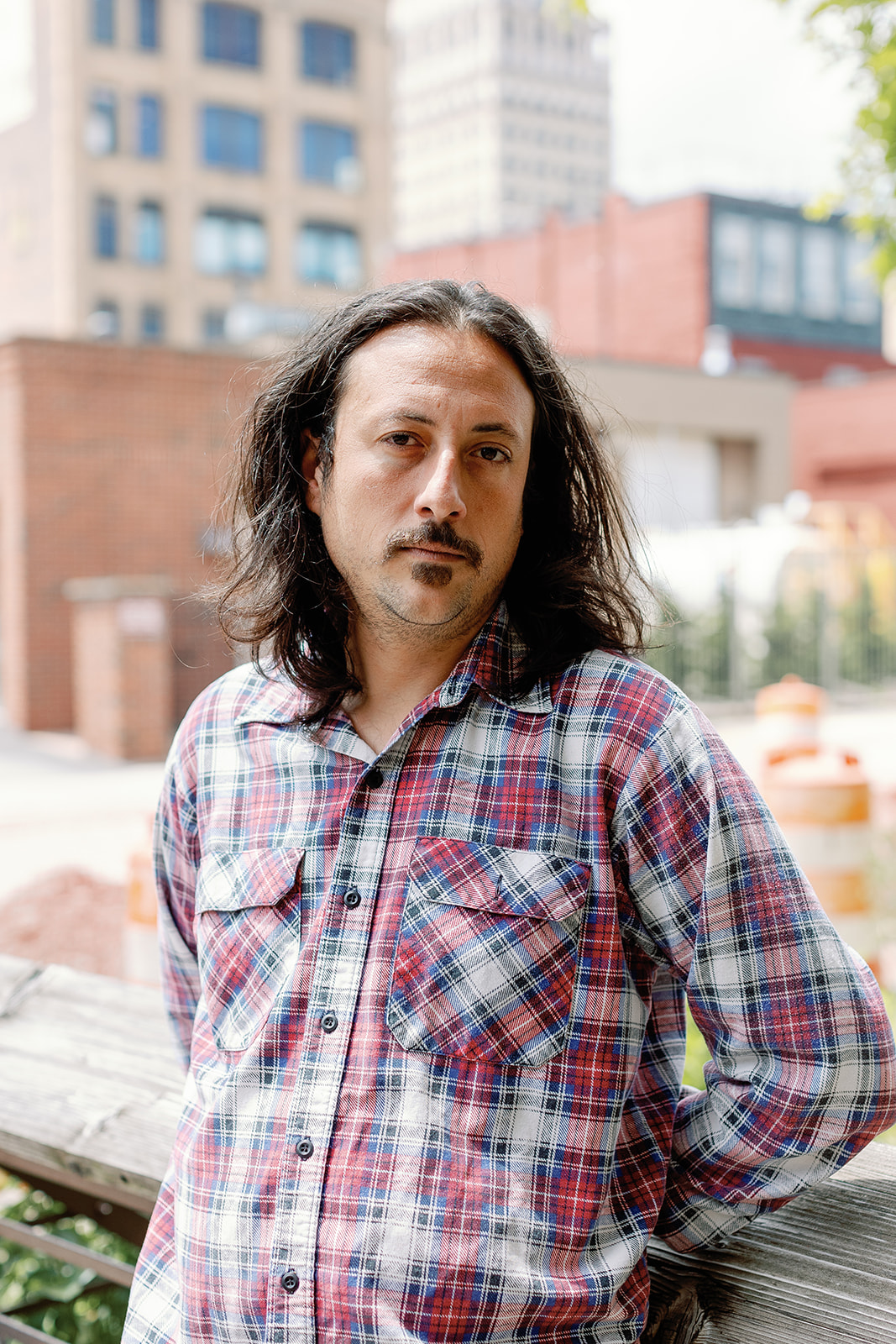
Alexander Fals
From a lineage of artists, and revolutionaries for social justice, Alexander Fals is his own genre. As a young man, he was deeply moved by the unique painting practices pioneered by his family in Colombia. He forages among the volcanic soil to process these pigments into paint. His portrait explores the controversy and the legacy of Nathanial Rochester as a tool to better understand our own biases.
Nathaniel Rochester
Lifespan: 1752-1831
Brief Family History: Nathaniel Rochester was born in Westmoreland County, Virginia. He was the son of John Rochester and Hester Thrift Rochester. Nathaniel married his wife, Sophia Beatty, in 1788, and they had twelve children together.
Career & Interests: Nathaniel Rochester’s career was marked by diverse interests and significant achievements. He began his professional life as a merchant and public servant in North Carolina. During the American Revolution, he served as a militia captain and later as a member of the North Carolina legislature. His interests spanned from politics to business, however evidence shows during his time in Maryland he both owned slaves and actively participated in the slave trade and continued to own slaves when he moved to New York.
Noteworthy Accomplishments: Nathaniel Rochester is best known for founding the city of Rochester, New York. In 1803, he and his partners purchased a large tract of land along the Genesee River in Western New York. Recognizing the area’s potential for industrial development due to its proximity to waterfalls, they laid out plans for a settlement. Under his guidance, the village of Rochesterville was established in 1817 and later became the city of Rochester. The myth that Nathanial Rochester was part of this city’s historical reform movements has been proven false, and points out that the struggle for equal rights touched the entire country.

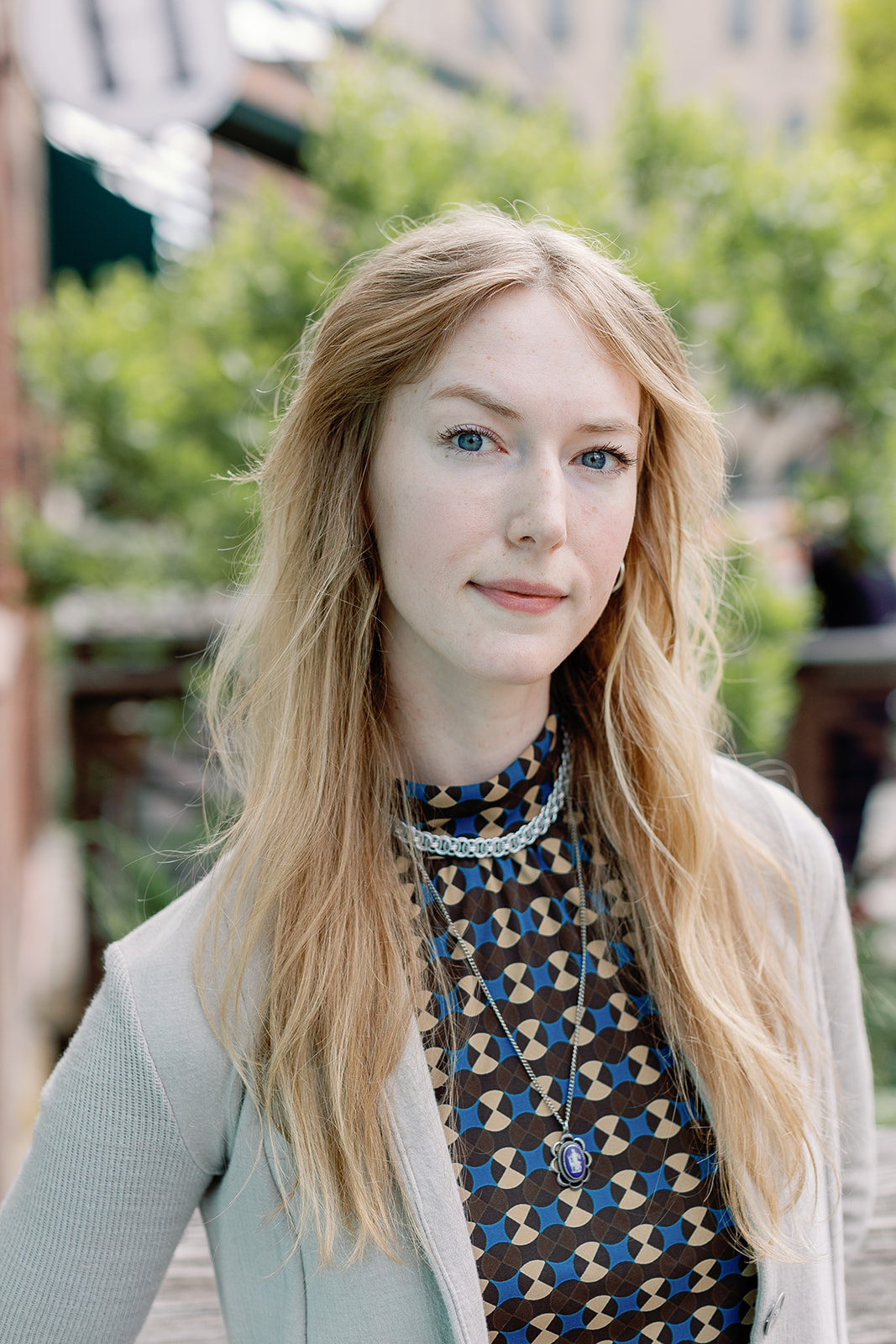
Cecily Culver
Cecily Culver is a creative professional with a background in sculpture and fine arts. At Stacy K Floral, she creates large scale floral installations. She delights in the opportunity to express her inner world and explore the outer world through visual and tactile artwork. Her work takes us from Gannett as a paperboy to a modern media publisher emphasizing the importance of words in daily life.
Frank Gannett
Lifespan: 1876-1957
Brief Family History: Frank Ernest Gannett was born in Bristol, New York, to his mother, Mary Jane Gannet, and his father, Joseph Charles Gannet.
Career & Interests: Frank Gannett’s career began in journalism, where he initially worked as a reporter for various newspapers. He quickly demonstrated a keen aptitude for the business side of the industry and, in 1906, co-founded the Elmira Gazette. He founded the Gannett Company in 1923, which would grow to become one of the largest newspaper chains in the United States. Frank was also deeply invested in civic affairs, education, and politics, reflecting his belief in the power of media to influence public opinion.
Noteworthy Accomplishments: Frank Gannett established the Rochester Times-Union in 1918, providing the city with a reliable and influential news source. Under his leadership, the Gannett Company acquired and improved several other newspapers, enhancing the quality and reach of local journalism. Gannett was a staunch advocate for journalistic integrity and innovation, which helped elevate the standards of the industry in Rochester and beyond. His contributions to the city included support for various civic initiatives, educational programs, and community development projects. In 1937, he established the Gannett Foundation, which continues to support charitable and educational causes in Rochester and across the country.


Madison Gardner
Madison Gardner is a multidisciplinary artist and naturalist. A lot of her work is inspired by the wildlife she sees on her hikes and the books she reads. Being able to cherish the unique landmarks throughout her home city is so special. She wanted the chance to execute a beautiful memorial to a Rochester hero because she knows it will help showcase the knowledge that was founded here.
Henry Ward
(This piece has been SOLD)
Lifespan: 1834-1906
Brief Family History: Henry Ward was born in Rochester, New York. His parents valued education and exploration, laying the groundwork for his future endeavors in geology and natural history.
Career & Interests: Ward’s academic journey began at Middlebury Academy and continued at Williams College and Harvard’s Lawrence Scientific School, where he studied under the eminent naturalist Louis Agassiz. His passion for geology and natural history led him to travel extensively in Europe, Africa, and the West Indies, collecting geological specimens and meteorites. In 1860, he returned to Rochester and became a professor of natural science at the University of Rochester.
Noteworthy Accomplishments to Rochester, NY: As a professor at the University of Rochester, Ward played a crucial role in advancing the study of natural sciences in the region. He was also an entrepreneur, founding Ward’s Natural Science Establishment. His establishment provided invaluable educational resources to schools and museums worldwide, elevating Rochester’s status in the scientific community. Today the company he founded, Ward’s Science, supplies science education materials to students of all grade levels. His legacy is commemorated at Mount Hope Cemetery by a Claude Bragdon-designed monument featuring a boulder with red jasper inclusions from Georgian Bay.
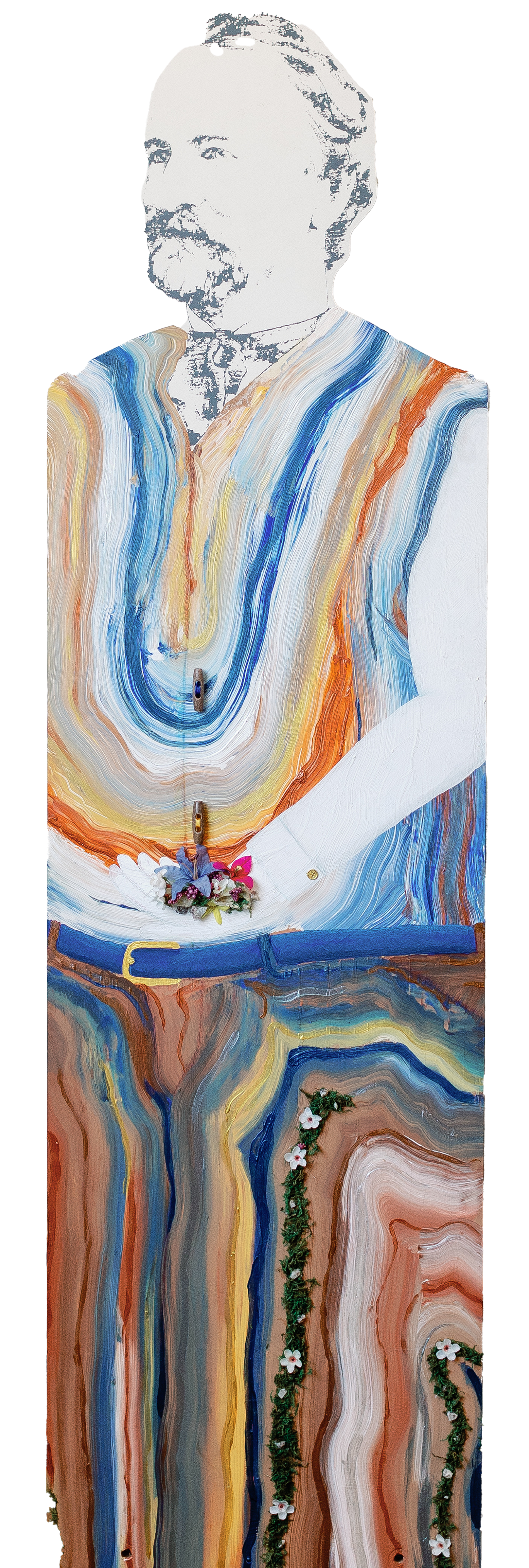
Sylvy Ruth Levy
Lifespan: 1917-1986
Brief Family History: Sylvy Ruth Levy was born in Rochester, New York. She was the daughter of Jewish immigrants. In 1943, she married Arthur Kornberg, a fellow scientist and future Nobel laureate.
Career & Interests: Sylvy Ruth Kornberg was a distinguished biochemist with a profound interest in enzyme research. She earned her bachelor’s degree in biochemistry from the University of Rochester and later worked at the National Institutes of Health (NIH). Her career was marked by a dedication to understanding the biochemical processes underlying DNA replication. Despite the challenges faced by women in science during her time, Sylvy maintained an active and influential role in her research community.
Noteworthy Accomplishments: Sylvy Ruth Kornberg made significant contributions to biochemistry, particularly in the field of DNA research. She co-authored numerous scientific papers with her husband, Arthur Kornberg, including groundbreaking work on the purification and properties of DNA polymerase. Her husband, Arthur Kornberg, won the 1959 Nobel Prize in Medicine for his research on DNA replication. However, it was Sylvy Kornberg who discovered an enzyme that enabled successful DNA replication. In Rochester, her legacy is honored through the University of Rochester, where she made many of these significant strides in scientific research.

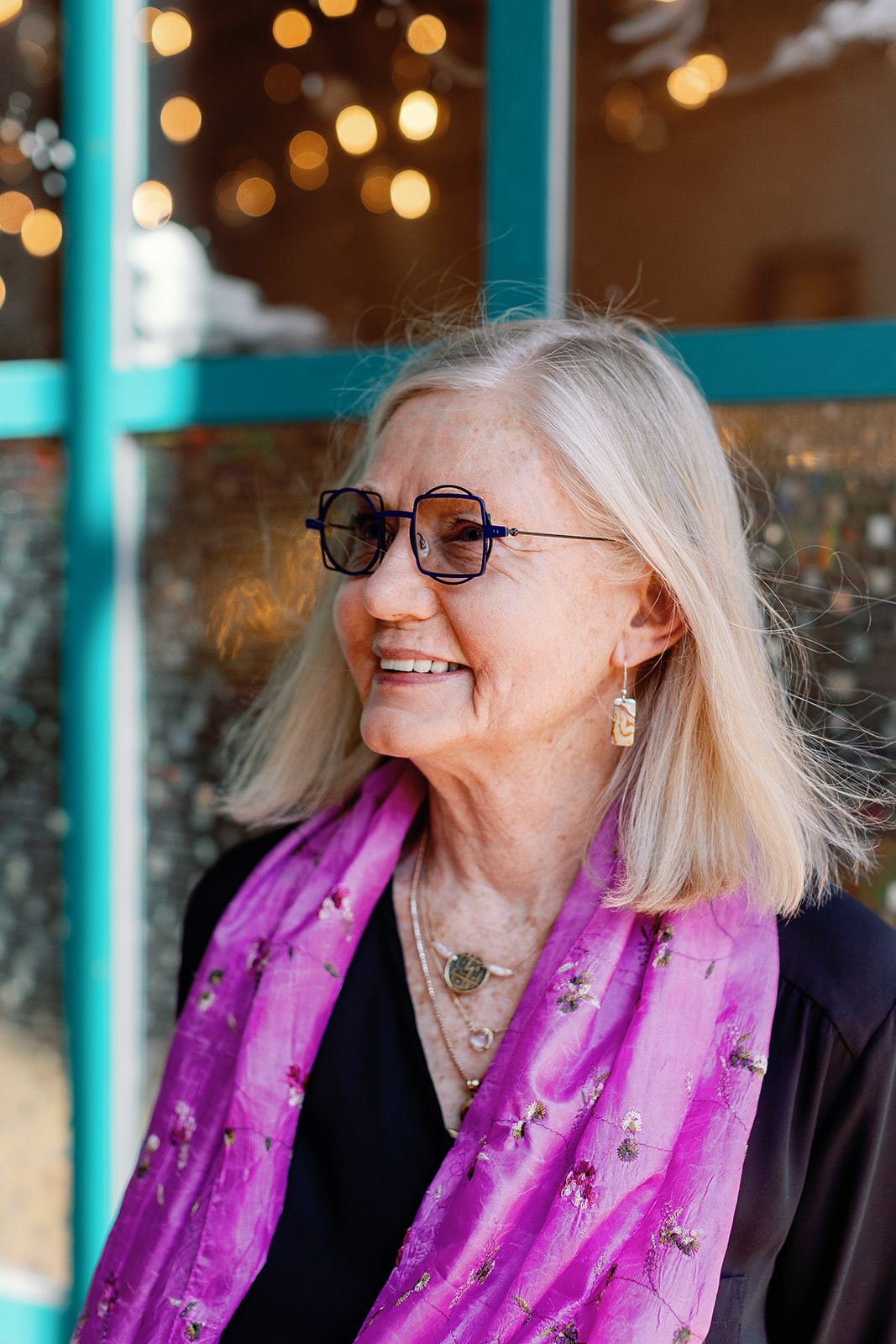
Jackie Germanow
Working directly, I use no preliminary sketches for paintings. Susan B’s wise, empathic face was my focus. I honed her force with my sense of what she communicated to the arena of human endeavor/beliefs. Her small underwater figure reflects the lives of women without voting power: submerged, jailed. Water, a metaphor for the unconscious, bubbles up further fermenting the work to its mysterious completion.
Susan B. Anthony
Lifespan: 1820-1906
Brief Family History: Susan Brownell Anthony was born in Adams, Massachusetts, to Daniel Anthony and Lucy Read Anthony. The Anthonys moved to Rochester, New York, in 1845, where they became active in the abolitionist movement.
Career & Interests: Susan B. Anthony dedicated her life to social reform, particularly focusing on women’s rights and the abolition of slavery. Her career began as a teacher, but she soon shifted to activism, driven by her belief in gender equality. She partnered with Elizabeth Cady Stanton to form a powerful team that fought tirelessly for women’s right to vote. Anthony traveled extensively, giving speeches, organizing events, and lobbying lawmakers to support women’s suffrage.
Noteworthy Accomplishments: Susan B. Anthony’s most significant accomplishments are closely tied to her work in Rochester, New York. Her home in Rochester served as a meeting place for numerous suffrage leaders and activists, and it became a central hub for the women’s rights movement. In 1872, Anthony was famously arrested for voting illegally in the presidential election, an act of civil disobedience that brought national attention to the suffrage cause. Anthony’s relentless efforts culminated in the eventual passage of the 19th Amendment in 1920, granting women the right to vote. Her legacy is preserved in Rochester through the Susan B. Anthony House, now a museum and educational center, commemorating her significant impact on the city and the nation.


Shawn Dunwoody
I consider myself a multi-disciplinary creative force for change. My experience as a Director, Producer, Designer, Developer, and Artist give me the opportunity to establish cutting edge, creative design in many forms. In everything I do, I bring a “stay creative” mindset and aim to integrate the needs of the people, the possibilities of technology, and the genius of great experiences.
Frederick Douglass
Lifespan: 1818-1895
Brief Family History: Frederick Douglass was born Frederick Augustus Washington Bailey in Talbot County, Maryland. His mother, Harriet Bailey, was an enslaved African American, and his father was likely her white owner, though details are uncertain.
Career & Interests: Douglass’s career and interests were deeply rooted in his experiences as an enslaved person. After escaping slavery in 1838, he became a prominent abolitionist, orator, and writer, dedicating his life to advocating for the rights of African Americans and the abolition of slavery. Douglass was an avid reader and self-educated, with a particular interest in literature. Throughout the 1840s and 1850s, he toured extensively, delivering powerful speeches against slavery.
Noteworthy Accomplishments: After moving to Rochester in 1847, he established the abolitionist newspaper The North Star, which became one of the most influential anti-slavery publications in the country. From his base in Rochester, Douglass used the newspaper to advocate for the abolition of slavery and the rights of African Americans and women, aligning with prominent figures like Susan B. Anthony. His home served as a station on the Underground Railroad, providing refuge and assistance to escaped slaves. Douglass’s Rochester homes on Alexander and South Ave. no longer are standing, but this incredible man is buried in Mt. Hope Cemetery.

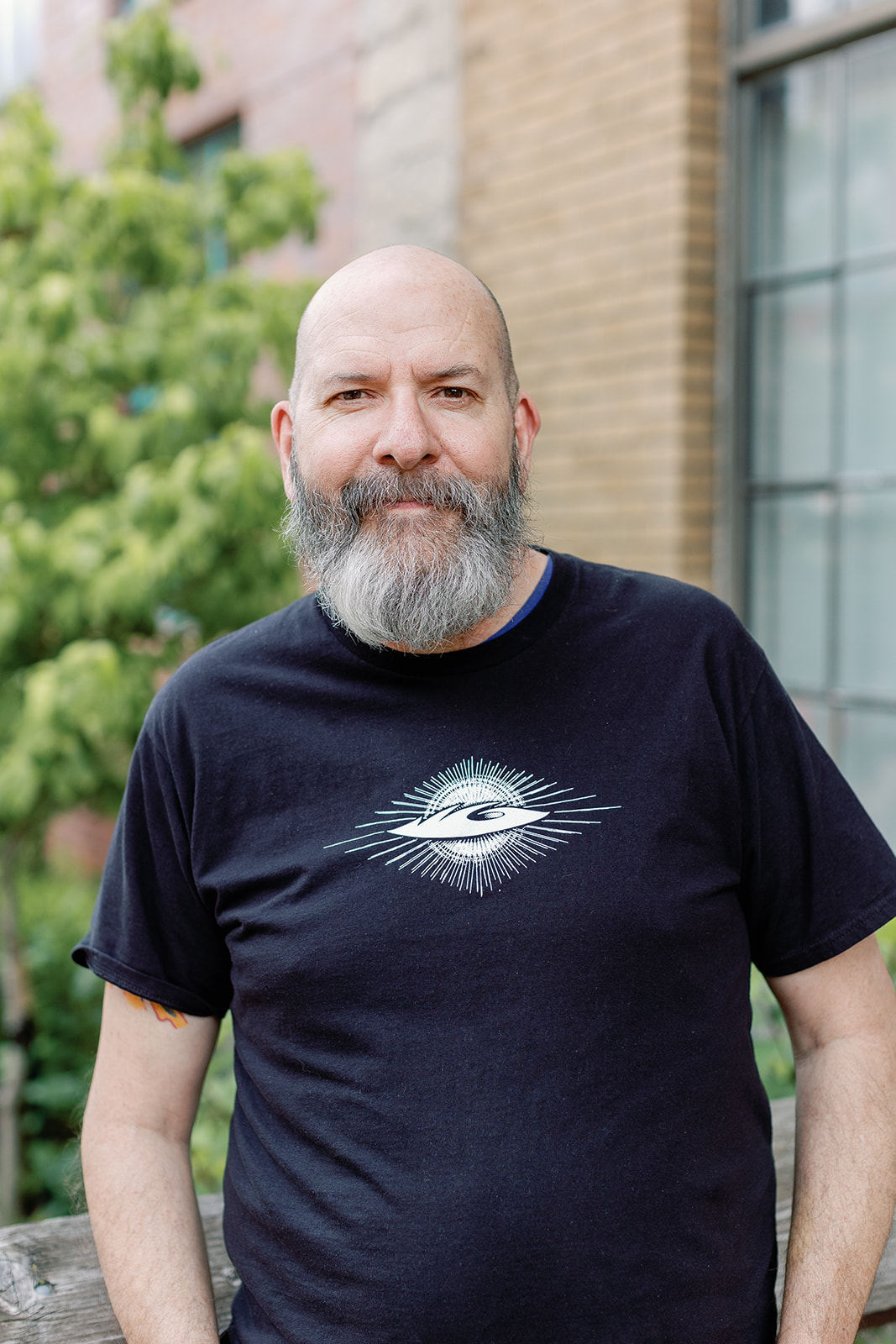
Mark Groaning
A seasoned mixed media artist, Mark’s career spans four decades. Influenced by nature’s magnificence and his own experiences, his art reflects profound insights that evoke strong emotions. The celebration of Rochester’s historic figures offers an opportunity to honor those that may have been overlooked. Lewis was Mark’s mentor for 30 years and his impact on Rochester’s art scene has been profound.
Louis Perticone
Lifespan: 1949 – 2024
Brief Family History: Louis Perticone hails from a family that valued creativity and community involvement, which greatly influenced his life’s work.
Career & Interests: Louis Perticone is a passionate advocate for the arts and a dedicated community leader in Rochester, New York. His interests span a wide array of artistic endeavors, including visual arts, music, and theater. His commitment to fostering creativity and supporting artists is at the core of his career.
Noteworthy Accomplishments: Louis Perticone’s most significant accomplishment is the establishment and development of Artisan Works. Under his leadership, Artisan Works has become a vital cultural hub in Rochester, offering a space where artists can create, exhibit, and sell their work. The organization houses thousands of artworks and provides educational programs, workshops, and events to engage the community with the arts. Perticone’s vision has transformed a former factory building into a dynamic space that celebrates local artists. His work has not only enriched the cultural landscape of Rochester but also inspired countless individuals to appreciate and participate in the arts. Through Artisan Works, Perticone has left his mark that ensures art remains accessible and integral to Rochester’s cultural fabric.
Garth Fagan
Lifespan: 1940-Present
Brief Family History: Garth Fagan was born in Kingston, Jamaica to his father, S.W. Fagan, who was the chief education officer in Jamaica, and his mother, Louise Walker, who was an accomplished dancer and dramatist.
Career & Interests: Garth Fagan’s career in dance began at a young age when he was exposed to a variety of dance forms in Jamaica. He later moved to the United States to further his studies and pursue his career in dance. Fagan’s style of dance combined elements of modern dance, ballet, Afro-Caribbean dance, and social dance to create a distinctive and innovative style known as the Fagan Technique. His interests extend beyond dance to include choreography and education, with a focus on training the next generation of dancers.
Noteworthy Accomplishments: Garth Fagan is best known for his groundbreaking work as the choreographer of Disney’s “The Lion King,” which earned him a Tony Award for Best Choreography in 1998. In 1970, he founded Garth Fagan Dance in Rochester, which has trained and inspired countless dancers. His company has performed worldwide, bringing Fagan’s unique vision to international audiences. Fagan’s legacy is one of innovation, dedication, and a deep commitment to the transformative power of dance. His work not only elevated the art form but also ensured that dance remains a vibrant and integral part of the community in Rochester and beyond.

You Could Be Famous
Imagine a person standing at the threshold of greatness, the kind of greatness that transforms cities and inspires future generations. This person could be anyone—young or old, from any background, with dreams that dance on the edge of reality and ambitions that stretch the bounds of possibility. This person could be you.
In the vibrant city of Rochester, New York, known for its rich history and pioneering spirit, the seeds of greatness are sown in every corner. From the innovative minds that drove the industrial revolution to the compassionate souls who championed social justice, Rochester has always been a cradle of change-makers and trailblazers. As you walk through the same streets, you carry the potential to be the next name etched into Rochester’s rich history.
You are the embodiment of limitless potential. Your journey is unique, filled with experiences that shape your vision and fuel your passion. Whether you are an artist, an entrepreneur, a scientist, or a community leader, your contributions can leave an indelible mark on the world. Your ideas can spark revolutions, your actions can inspire movements, and your dreams can build legacies.
So, look within yourself. Embrace your passions, pursue your goals with tenacity, and remember that you have the potential to be a beacon of inspiration. Your story could be the next chapter in Rochester’s illustrious history.You could be famous.


Taryn Juanita
Taryn Juanita is a local visual artist with a diverse portfolio of commissions in Rochester, including one of her grandmother’s. She uses acrylics, charcoal and water paint to tell a story. Her art tells the tales of the ancestors who lived before her! Through much chaos, life is possible. She finds being an artist is a beautiful imitation of life and its gifts.
Abelard Reynolds
Lifespan: 1785-1878
Brief Family History: Abelard Reynolds was born in Red Hook, New York. He married Lydia Strong in 1807, and their family moved to Rochester in 1812.
Career & Interests: Reynolds began his career as a blacksmith, but his entrepreneurial spirit soon led him to other ventures. After moving to the “100 acre tract”, he became the first saddle maker, the first magistrate and the first inn-keeper. His interests spanned real estate, hospitality, and community development, reflecting his keen business acumen and commitment to the area’s growth.
Noteworthy Accomplishments: Abelard Reynolds played a crucial role in the early development of Rochester, New York. He built the Reynolds Arcade, which not only provided lodging but also housed the first offices of Western Union, Bausch & Lomb, and George Eastman had his first job there. The original Arcade was raised in 1932. Reynolds was also instrumental in establishing the first post office in Rochester, serving as the city’s first postmaster. He co-founded Rochester’s first public library and was a member of the first board of education.
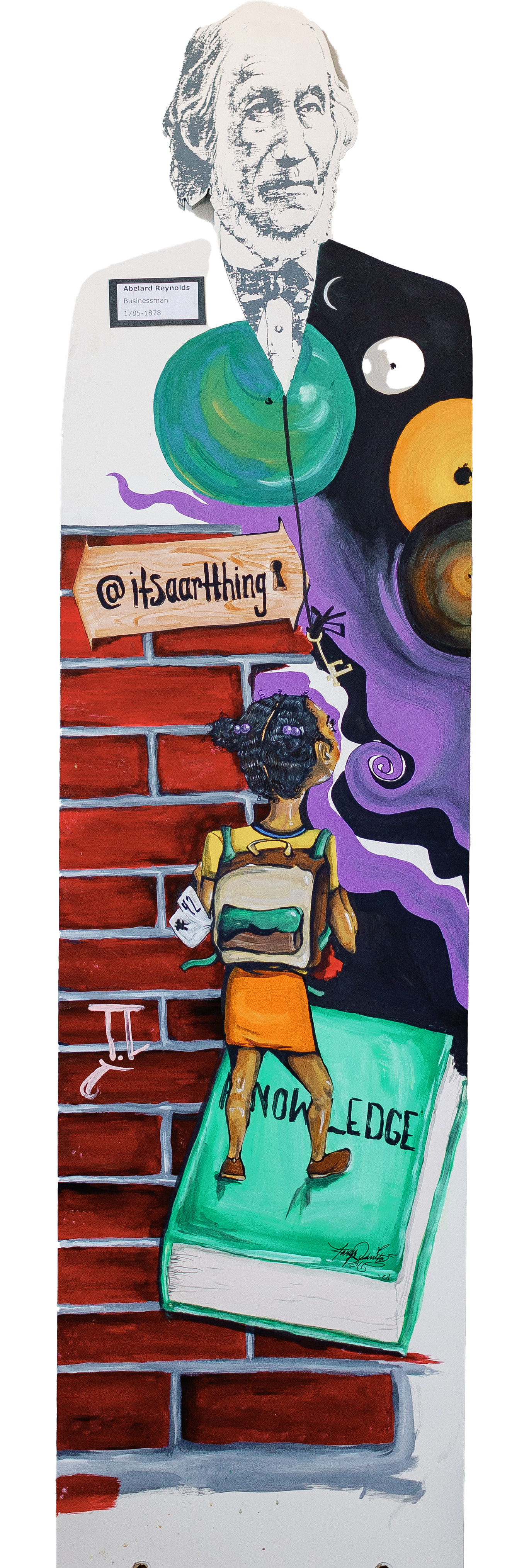
Mathew & Francis Brown
Lifespan: Mathew Brown 1766 – 1851 | Francis Brown 1774 – 1824
Brief Family History: The Brown brothers, Matthew and Francis, were early settlers in the Rochester, New York area.
Career & Interests: Matthew and Francis Brown engaged in various business ventures that laid the groundwork for their later successes. The brothers first operated in the milling industry, a critical sector in the region’s early economy. In addition to milling, the Browns also engaged in other entrepreneurial activities, such as land development and trade, which helped them accumulate the capital and resources needed for larger projects.
Noteworthy Accomplishments: The Brown brothers’ most significant accomplishment was the construction of Brown’s Race in 1815. This power canal was essential for the early industrialization of Rochester. It diverted water from the Genesee River to drive water wheels for mills and factories, facilitating the city’s transformation into a major manufacturing center. Their work on Brown’s Race directly supported the growth of numerous industries, including flour milling, which was central to Rochester’s economy. The infrastructure they built laid the foundation for Rochester’s development and prosperity. Today, the Brown’s Race Historic District is a testament to their impact on the city’s history.

Elisha Johnson
Lifespan: 1785 – 1866
Brief Family History: Elisha Johnson was
born in 1785 in Oneida County, New York.
Career & Interests: Elisha Johnson
was a skilled civil engineer and surveyor
in Rochester, New York. He was deeply
interested in urban planning, architecture,
and infrastructure. Johnson’s expertise in
civil engineering led him to work on various
important projects, including roads, canals,
and public buildings. His passion for building
and development was evident in his work
throughout his career.
Noteworthy Accomplishments: Elisha
Johnson’s contributions to Rochester were
pivotal in shaping the city’s early growth and
development. He served as the city’s mayor
from 1838 to 1839 and was instrumental in the
construction of several key infrastructures.
One of his most notable accomplishments was
his role in the design and construction of the
Third Ward (now known as Corn Hill), which
became one of Rochester’s most distinguished
residential areas. Johnson also oversaw the
building of the Rochester Aqueduct, a vital
structure that facilitated the Erie Canal passage
through.
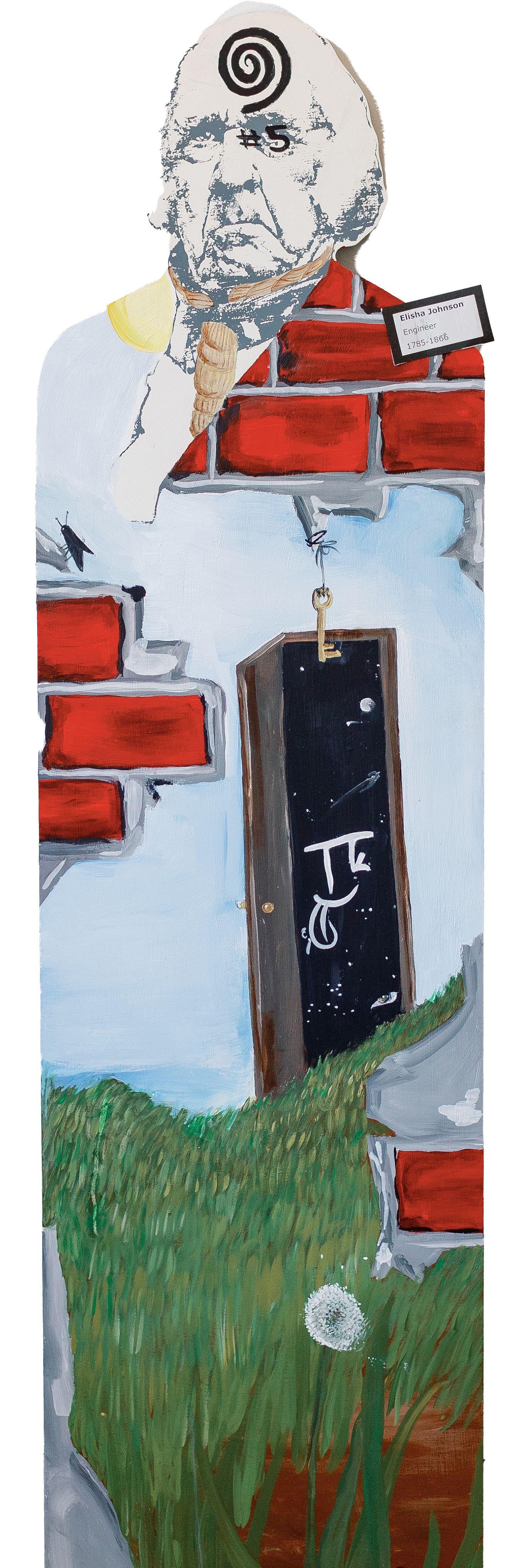
What is this project all about?
In 2019, the City closed the Visitor Center in High Falls and auctioned everything. Greentopia purchased the exhibit of 33 pressboard silhouettes of “Famous Rochesterians.” This project seeks to engage local area artists in reimagining, interpreting, and putting into visual context the natural and cultural heritage surrounding Rochester history.
Greentopia has reached out to area artists to help kickstart a conversation about how our natural and cultural heritage will lead to building a park that is meaningful, accessible, and relevant and inspires citizen belonging.
What are the core goals of this project?
Through this project, Greentopia hopes to:
- Preserve history through art and storytelling.
- Celebrate Rochester’s rich natural and cultural heritage.
- Engage local artists to ‘reimagine’ 33 famous Rochesterians.
- Showcase local artists’ renderings of “Famous Rochesterians” that will be displayed in City libraries in July.
- Encourage community participation through a scavenger hunt and a 2-month public exhibit.
We also plan to publish a book highlighting the artists and the artwork and delving into the history and stories surrounding impactful Rochesterians.
Artists are compensated for their time and creativity. Greentopia will auction the figures at its major fundraiser on August 1st, held at the downtown Public Library.
All proceeds go directly to support the Green Visions Workforce Development Program and further our efforts to promote the Park.

